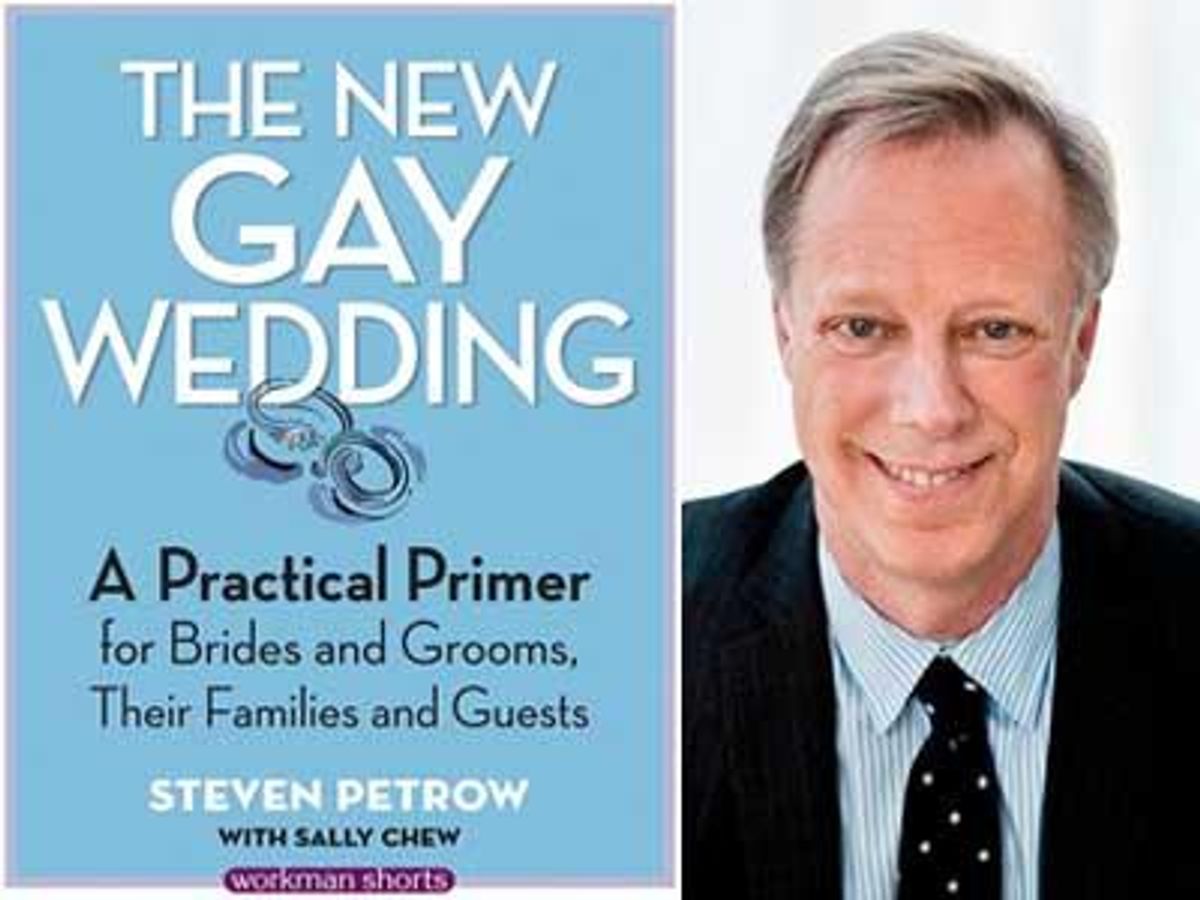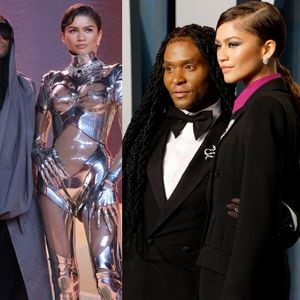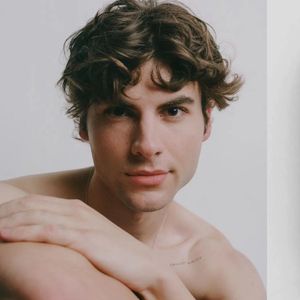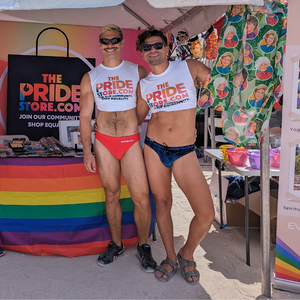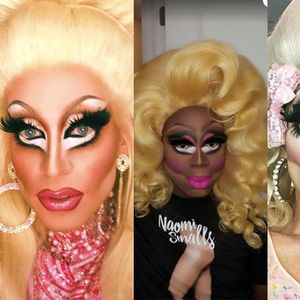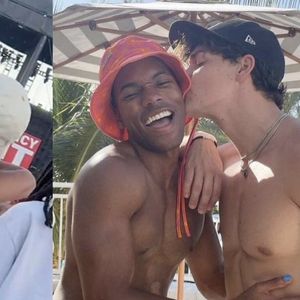When LGBT couples wed, these ceremonies range from down-home to a near state affair. You will find plenty of lace and taffeta at LGBT weddings (as well as less frilly fabrics) and generally lots of tuxedos -- the latter are a favorite not only when gay men tie the knot but also among lesbians and transmen. On the other hand, LGBT couples also tend to bend traditional fashion rules for weddings, sometimes simply by mixing gender traditions or combining fashions in other unique ways.
What Two Brides and Two Grooms Wear
Before you go off and buy (or rent -- see below) your wedding attire, it's important to remember all those decisions you should have made by now: How formal a wedding will it be? What season will it take place? What's your budget? Are there any religious or family traditions to consider (such as having your head covered or wearing your mother's wedding dress)?
Once you've answered those questions, you're well on your way. If you decide to buy your dress or other attire, be sure to give yourself sufficient time -- months! -- both to shop and to have any necessary fittings. Many couples start this process as soon as they've set the ceremony date. Even an off-the-rack dress or a new suit may need to be altered -- sometimes more than once if you lose or gain weight.
Levels of Formality
Traditionally weddings usually fall into one of these three categories, which set parameters for what the couple (and their guests) wear:
* Formal: Black tie or white tie for men (tuxedos); a classic wedding gown (i.e., a long white dress with a veil).
* SemiFormal: Dark suits (black, charcoal, or navy), white shirt, and tie for men; for women: a traditional gown, but with no train.
* Informal: Either a suit or a sports coat and slacks for the men, usually with a tie (unless it's a beach wedding or at an exotic destination); a cocktail dress, suit, or pants suit for women.
Variations exist for each level of formality. For instance, a semiformal or informal wedding in the evening is usually dressier than a daytime one. In warmer climates, linen and white suits are appropriate for men at any wedding other than a formal one; brides may choose gowns or dresses in lighter fabrics, too: linen, silk, and taffeta are good choices for both comfort and style.
Your Own Style
Many LGBT couples create their own styles to suit their personalities and the nature of their ceremony -- and some eschew any part of tradition. For instance, a couple having a domestic partnership at city hall may wear business attire (men: suit and tie; women: daytime dress or coordinated top and slacks) or a more festive outfit of their own choice. At a more formal wedding, you may find two brides, one in a traditional white gown, the other in a silk pantsuit. While there's no need to be matched, you'll want to find a way to complement each other. A Caucasian man who married his Asian partner in a commitment ceremony explained, "I wore a white linen suit, and Gerard wore a long white linen Nehru-style tunic with matching trousers."
Renting Your Wedding Outfits
LGBT couples frequently turn to renting their wedding attire as a cost-cutting measure (a new tuxedo or an upscale gown can cost more than you might imagine). Renting an outfit is easy, generally economical, and amazingly convenient (because it's fine if you return it with cake all over it). If you know you'll be wearing a tux, reserve yours several months in advance of the celebration, especially if the wedding happens to fall in prom or high-wedding season (late spring or summer). Look for one that fits you well, is not worn or faded, and reflects your style, whether classic or contemporary.
Women's tuxedos (which can also be rented at many mall tux shops) are becoming increasingly popular for lesbians. Usually, they're tailored and can be butched up or femmed down through your choice of blouse, shoes, and other accessories. A complete outfit includes tuxedo pants and shirt, as well as a silk bow tie with either black Mary Janes or patent leather flats. Some women opt for western-style tuxes, fitted white dinner jackets, as well as tuxedo skirts. Brides-to-be can also rent gowns -- either in brick-and-mortar stores or online.
How Attendants Dress
How the wedding couple dresses informs what their attendants will wear. If the brides and grooms are wearing formal attire, so, too, should the attendants. Casual clothes --ditto. A rather unpopular wedding tradition is the "edict" that bridesmaids or attendants dresses should be completely identical. Such rigor certainly makes for uniformity in wedding photos, but the often pricey outfits are too often not what a guest would have chosen to wear -- or would ever wear again. (If you're being asked to be in the wedding party, it's important to ask about your attire -- and especially how much it could cost you.)
Generally, however, the dress code is more lax at LGBT affairs, except for the most formal ones. Many gay couples forgo the "matching" in favor of having attendants simply dress "alike." For instance, brides or grooms might suggest a color palette for the female attendants. In fact, many attendants are generally thankful for a little bit of direction when it comes to the actual shopping. Said one lesbian: "When my best friend decided to marry her girlfriend, I was thrilled to be asked to be an attendant, but even happier when she said the only rule was 'wear a black dress.' We all were able to choose styles that flattered our bodies. And I can still wear that dress!" Another benefit: The wedding party looked similar -- and distinct from the guests.
Some LGBT brides and grooms will designate a particular rental store for members of the wedding party and perhaps even a specific tuxedo style. Play along, even if it's not your first choice in fashion. Of course, if you already have your own, simply accessorize it to match the others in the wedding party.
How Guests Dress
Guests offer their respect and support for the couple by neither competing for the limelight nor distracting the other guests by dressing off note or too "original." That holds true whether it's a theme wedding -- for instance, with everyone in western gear and cowboy hats -- or a high-church affair with organ music and formal attire.
When in doubt about what to wear to a particular wedding, pay close attention to the style of the wedding invitation. A formal wedding will usually be preceded by a formal invitation; similarly the invitation for a casual affair or one suggesting "festive attire" will be reflected in the invitation style, and perhaps in the actual language within the invitation packet. If you remain confused, talk to someone in the wedding party for guidance.
Attire for Trans Brides and Grooms
Transmen and -women looking for something special to wear to a wedding -- whether their own or somebody else's -- may go the androgynous route, or amp up the masculine or feminine wedding traditions. Think frothy white gowns with endless trains and shiny black tuxedos with starchy collars. Tuxedos are classic wedding garb for trans men, not just because they make you look handsome but also because they shout out "gentleman" and "playboy" at the same time.
Whatever fashion route you favor, the shopping trips and multiple fittings that characterize so many weddings can be anxiety-inducing. Unfortunately, unless you have access to a rare trans-friendly clothing establishment or can afford to hire a designer of your own, you can expect some shade from store clerks. Wherever you shop, you may find the experience more pleasant if you're up-front ahead of time about being transgender.
Not surprisingly, shopping online can be a great solution for trans people. Large-size pumps are to be had for transwomen on the Internet, alongside dresses to suit broader and sometimes fuller bodies. And for transmen seeking a classic look, tuxes come in all sizes and shapes.
If you do shop online, your best bet is to hire an LGBT-friendly tailor to put it all together nicely once your purchases arrive. Good fit is the key not just to "presenting" the way you want, but also to being a beautiful bride, a handsome groom, or a smart-looking guest.
STEVEN PETROW is The Advocate's manners columnist and author of Steven Petrow's Complete Gay & Lesbian Manners and can be found online at www.gaymanners.com, or contact him on Facebook and Twitter. Got a question? Email Steven at ask@gaymanners.com. THE NEW GAY WEDDING: A Practical Primer for Brides and Grooms, Their Families and Guests (Workman Shorts; $1.99, electronic) is a handy, one-stop shop for same-sex couples planning their big day. It's also available via Amazon.
